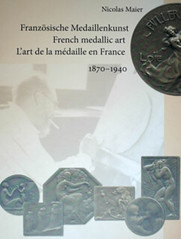
PREV ARTICLE
NEXT ARTICLE
FULL ISSUE
PREV FULL ISSUE
BOOK REVIEW: FRENCH MEDALLIC ART: 1870-1940
Dick Johnson submitted this review of French Medallic Art: 1870-1940 by Nicolas Maier. Thanks!
Dick supplied the book image and portrait of the author below, and has copies of the book on the French SAMF Art Medal series for sale in his ad elsewhere in this issue.
-Editor
For the decade I was a medal dealer, in the 1970s and 80s, I even sold some of the medals in that series unaware they were part of a magnificent group that showcased the best medallic art of the French practitioners of this glyptic art. My shortcoming.
Also -- to give perhaps a sense of the beaux arts climate in which these medals were issued -- he discusses 73 French medallists and their medallic creations to provide the influence this series had on other medalists of the period. The Societe des Amis de la Medaille francaise (the Society of French Medallic Art) which the author refers to as SAMF throughout the book, was formed by art critic Roger Marx the last year of the 19th century, 1899. In a touch of French irony this is the same year that Victor Janvier was granted the patent for his reducing machine, his pantograph that was to have such an influence on the French development of this art. For now -- after centuries of tedious hand engraving dies in exact size -- an artist could model in clay, or wax, to create an oversize pattern of his intended medal. Knowing full well, his images would be reduced with great fidelity on Janvier's magic-like pantograph to cut a die that could stamp his intended images in permanent bronze or other metal in the required size for any number of desired specimens. This was a far superior method of medal making than the casting of large medals one at a time by foundry casing methods previously employed for such medallic items. The plan of SAMF was to issue five new medals a year, this was accomplished for the first decade, from 1899 to 1909 (save the first year and 1908 when only four each were issued). With this requirement there was no attempt to have each new medal by a different artist. It appears whoever came up with a suitable model, theme and satisfactory execution got the commission from Marx. Design, content, style, lettering was all the choice of the artist for each of the 63 medals in the series. Let the artist be inspired, let his creative juices flow. This is great medallic art. Themes of nature, children, animals abound in the series. Universal appeal to any viewer! The author credits David d'Anders (1788-1856) for his portrait reliefs, beginning in 1825, as a forerunner of French medallic art. Likewise he names Herbert Ponsdcarme (1827-1903), considered the Father of the Modern Art Medal with his 1863 medal for the Academy of Inspiration for Beaux-Letters bearing the portrait of Joseph Nadet. These artists inspired Roger Marx to create a series to promote French medallic art. His idea was copied by a similar series in the Netherlands, and, in America (with the 12-medal Circle of Friends). Perhaps it could be considered the concept for the later American series of the Society of Medalists as well (with only two medals a year, each named for their issue number, and each intended to be by a different American artists).. All these series gave the artist free reign in designing and modeling a theme of his choice. This in contrast to a commercial commission to honor an anniversary or some celebratory event with a design thrust upon the artist. The illustrations alone are worth the cost of the book, with 73 single-sided medals and 275 two-sided medals pictured. Plus images from the Paris Mint at the turn of the century where most of these medals were struck on the equipment illustrated. That giant balancier (screw press) page 26 could strike medals in large size.
Don't overlook the chart, page 62-63, which lists all SAMF medals. Wished I had had that list forty years ago. The text is in English, French and German. Recommended.
The Numismatic Bibliomania Society is a non-profit organization promoting numismatic literature. See our web site at coinbooks.org. To submit items for publication in The E-Sylum, write to the Editor at this address: whomren@gmail.com To subscribe go to: https://my.binhost.com/lists/listinfo/esylum All Rights Reserved. NBS Home Page Contact the NBS webmaster 
|

